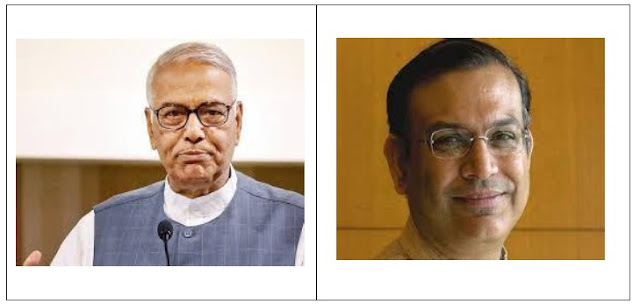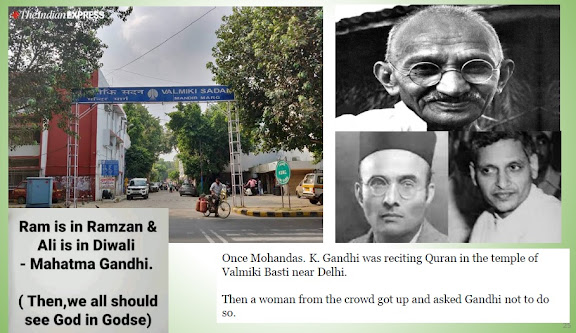Yaswant Sinha Vs Jayant Sinha – Father Vs Son by Pavithran
(an article
published in the Indian Express)
Sinha had criticized the Modi Government in a most uncharitable way even though he is still a BJP – more
critical than the Opposition Parties put together.
According to him, while Demonetisation is an unmitigated economic
disaster, GST – a badly conceived and poorly implemented has done havoc with
the economy thereby making countless millions losing jobs and new entrants
hardly having any new opportunites to the labour market.
Point 1: Growth rate of economy
reached 5.7 % in the first quarter of the current fiscal year – lowest in three
years. The methodology for calculation of
the GDP was changed by the present government in 2015 as a result of which the
growth rate recorded earlier increased statistically by over 200 basis points
on an annual basis. So, according to the old method of calculation, the growth
rate of 5.7 per cent is actually 3.7 per cent or less.
Point 2: Bonanza due to low oil
prices with lacs of crores of rupees is not put to proper use – but wasted along with
stalled projects and NPAs.
Point 3: Indian Economy is at its
worst – Private Investment, Industrial Production, Agriculture, Construction
Industry, Service Sector, Exports – all shrunk, collapsed, dwindled and in
doldrums.
Point 4: Demonitisation – economic disaster and GST – badly
conceived and poorly implemented having played havoc with businesses and
resulting in job loses with no opportunities for the new entrants to the labour market. In fact demonetization is
not a reform at all – it was an administrative measure. Objectives of
demonetization had failed, as the entire black money is back in the system and
hence demonetization, apart from disrupting the economy, has made no other
contribution.
Point 5: Input tax credit demand
under the GST is Rs.65,000 crore as against a
collection of Rs.95,000 crore.
General Comments:
•
Arun
Jaitley - a defeated MP in the election
was chosen as the Finance Minister and given 3 or 4 important portfolios
including that of Defence. Hence it is impossible for any one in that position
to do full justice to his main portfolio – viz. finance.
•
Raid
Raj had created fear complex in the
minds of the people.
•
Economic
Recovery not possible by 2019 – the election year and BJP will end up in hard
landing.
•
The
prime minister claims that he has seen poverty from close quarters. His finance
minister is working over-time to make sure that all Indians also see it from
equally close quarters.
Sinha, though a former BJP Finance Minister, is not an
economist – but that does not mean that he is not competent to air his views as
per his assessment. It would have been better, if Sinha had given some data
to prove his points instead of generalizations and accusations and sarcastic
comments.
To my mind, there are only two valid points raised by Sinha – Point No.1 about
GDP and Point No.5 – GST Collections vs
Tax Credit Demand.
Let me answer these
two points first and tackle other points later.
Demonetisation and GST are two major economic
surgical strikes initiated by Modi Government. Hence there will be
initial setbacks which will find its logical levels and then the economy will
pick up speed.
Demonetisation had resulted in white economy to
the forefront and in the process killing black market, counterfeit currencies
etc. which are real menaces for a healthy growth for a country.
The downfall of GDP for the present quarter will be set right in the near
future and there are other parameters which are quite favourable like the World Economic Forum
Report ranking India at 40th position amongst 137 countries from
71st rank three years ago.
Incidentally, Morgan Stanley had predicted India likely to be the world’s
fastest-growing large economy in the next 10 years, driven by digitations, favourable demographics, globalization and
reforms. Hence, Morgan Stanley’s observations here are a direct hit and answer
to what Sinha said in Point No.3.
Point No.5 – about tax credit demand vs collection under the GST, Sinha himself had answered by stating that the Government has asked the income
tax department to chase those who have made large claims! Even in Demonetisation, it is good that almost all note
ban notes of Rs.500 and Rs.1000 had come to the Bank Vaults and steps have been
initiated to find those who had deposited huge money so as to levy taxes on
those hitherto unaccounted money deposits.
Point No.2 in General Comments – Raid Raj:
Sinha has questioned tax notices. In a
country where only 4 per cent of the people pay income tax, even if all the tax
payers get notices, it will still not be widespread. Yes, they are a very
influential class. In a country where one per cent of the population is holding
58 per cent of the national wealth, some sort of affirmative action had to be
taken. And Modi has done it. Yashwant Sinha is speaking as if he holds a brief
for these hoarders, black money and fake currency peddlers.
Here, it is pertinent to add that Jayant Sinha, Minister of State for Civil
Aviation and son of Yaswant Sinha, had chosen to answer his father’s
accusations in an article published in The Times of India on the next day of
his father’s article published in the Indian Express under the heading: New economy for new India: Fundamental changes put in place
for an open, transparent, competitive and innovation-driven economy.
Jayant Sinha was earlier Minister
of State for Finance and hence his reply is quite relevant and opt. But, Yashwant Sinha had taken objection
to his son taking on his shoulders to reply to his criticism thus: “My simple
reaction is that it is not a father-son issue, it is not a family issue with Jayant on one side and I on
the other. That is a national issue and, therefore, if anyone is trying to
debase it or turn it into a family issue it should be condemned. If it is a
question of national interest, other interests become insignificant. And if
there is a collateral damage to his career, so be it.”
Such a stand – instead of replying to his son’s comments
– only shows Yaswant Sinha’s weaknesses in
dealing with political issues without bringing his family relationship and his
concern for his son’s political career is quite strange and making him small in
the eyes of others.
This Link will lead you to Jayant Sinha’s article wherein he
had answered all points raised by his father.
Click LINK
For the benefit of readers, the main counter points put
forth by Jayant Sinha are culled
hereunder:
qSeveral articles
written recently on the challenges facing the Indian economy unfortunately draw
sweeping conclusions from a narrow set of facts, and quite simply miss the
fundamental structural reforms that are transforming the economy. Moreover, one or two quarters of GDP growth
and other macro data are quite inadequate to evaluate the long-term impact of
the structural reforms underway. These structural reforms are not just
desirable, they are necessary to create a ‘New India’ and provide good jobs for
our billion-strong workforce.
qGST, demonetisation and digital payments
are game-changing efforts to formalise India’s economy. Transactions that were taking place
outside of the tax net and in the informal sector are now being brought into
the formal sector.
q The Bankruptcy Code
will enable speedy resolution of stressed assets providing relief to NPAs in
the banking sector.
qThe Jan Dhan-Aadhaar-Mobile (JAM) trinity
is powering Direct Benefit Transfer (DBT) and dramatically reducing leakages.
Rs 1.75 lakh crore of benefits have
been transferred directly to beneficiaries over the last three years. JAM is
weeding out many ghost and fake beneficiaries and cutting out middlemen.
qThe National
Investment and Infrastructure Fund has been established to provide long-term
equity risk capital for the development of world-class commercial
infrastructure projects in conjunction with other long-term global investors.
q100% village
electrification by 2018 with the number of villages remaining to be electrified
having decreased to only 4,941 villages by 2017 from 18,452 in 2014,
Construction of Rural roads at a record
rate of 133km per day, almost double the rate of 69km per day in 2014, housing
for all, gas connection for all, health insurance at affordable cost, banking
for all, education for all.
q New Economy is all
set to create New India by 2020.





Comments